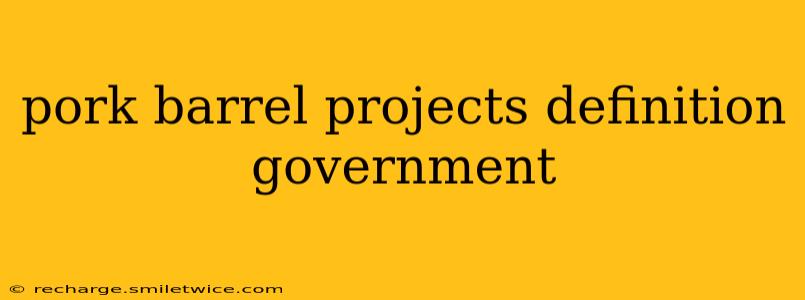Pork barrel spending, also known as pork, is a derogatory term referring to government spending on localized projects secured solely or primarily to benefit a particular legislator's constituency. These projects are often seen as wasteful or unnecessary by critics, who argue they prioritize political gain over sound fiscal policy and effective public spending. Understanding the definition, examples, and impacts of pork barrel projects is crucial for comprehending the complexities of government budgeting and political maneuvering.
What is the definition of a pork barrel project?
At its core, a pork barrel project is a government expenditure that lacks broad public benefit, instead serving a narrow, often localized, constituency. These projects are frequently included in larger appropriations bills, making them difficult to scrutinize individually. The key characteristics include:
- Limited Public Benefit: The primary benefit accrues to a specific region or group, rather than the general population.
- Political Motivation: The project's approval is primarily driven by the political influence of a legislator, rather than objective need or merit.
- Lack of Transparency: The decision-making process surrounding pork barrel projects can be opaque, with limited public debate or analysis.
- Often Excessively Expensive: The cost of the project may significantly exceed its actual value or necessity.
What are some examples of pork barrel projects?
Examples of pork barrel projects are numerous and vary widely depending on the jurisdiction and political climate. They can include:
- Bridges to Nowhere: Infamous examples include bridges built to connect sparsely populated areas, costing millions with minimal practical use.
- Unnecessary Roads or Highways: Construction of roads or highway expansions in areas where existing infrastructure is adequate.
- Overfunded or Unnecessary Studies: Research projects that are excessively expensive or lack clear goals and measurable outcomes.
- Stadium Funding: Subsidies for sports stadiums or arenas, often benefiting private entities more than the public.
- Earmarks for Specific Companies or Industries: Allocating funds to specific companies or industries, favoring certain economic sectors over others.
Why are pork barrel projects controversial?
Pork barrel spending is highly controversial for several reasons:
- Wasteful Spending: Critics argue that pork barrel projects represent a misallocation of public funds, diverting resources from more pressing needs.
- Lack of Accountability: The opaque nature of the process often makes it difficult to hold legislators accountable for wasteful spending.
- Political Corruption: Pork barrel projects can contribute to political corruption, as legislators may trade votes or favors to secure funding for their pet projects.
- Inefficient Allocation of Resources: The focus on localized benefits often ignores broader national priorities, leading to inefficient allocation of resources.
How do pork barrel projects impact government?
The cumulative effect of pork barrel spending can significantly impact government:
- Increased National Debt: The accumulation of wasteful spending contributes to increased national debt.
- Erosion of Public Trust: Pork barrel projects can erode public trust in government and the political process.
- Distorted Policy Priorities: Focusing on localized benefits can distort government policy priorities, shifting attention away from broader needs.
- Reduced Government Efficiency: The time and resources spent on securing pork barrel projects can divert attention from more pressing issues and reduce overall government efficiency.
What are the arguments for pork barrel projects?
While largely criticized, some argue that pork barrel projects have certain benefits:
- Economic Development: Proponents argue that these projects can stimulate local economies and create jobs.
- Meeting Specific Needs: They can address specific infrastructural needs or other localized problems that may not be addressed through other funding mechanisms.
- Political Bargaining Tool: Supporters argue that they are a necessary tool for political compromise and negotiation in the legislative process.
Are there any regulations to control pork barrel spending?
There have been efforts to reform and regulate pork barrel spending, often focusing on increased transparency and accountability. These reforms vary across jurisdictions and frequently face strong opposition. The effectiveness of such regulations is often debated.
In conclusion, pork barrel spending is a complex and controversial aspect of government finance. Understanding its definition, examples, and impact is critical to evaluating government efficiency and fiscal responsibility. While arguments for its benefits exist, the significant downsides related to wasteful spending, lack of transparency, and potential for corruption outweigh any perceived positives in most cases.
